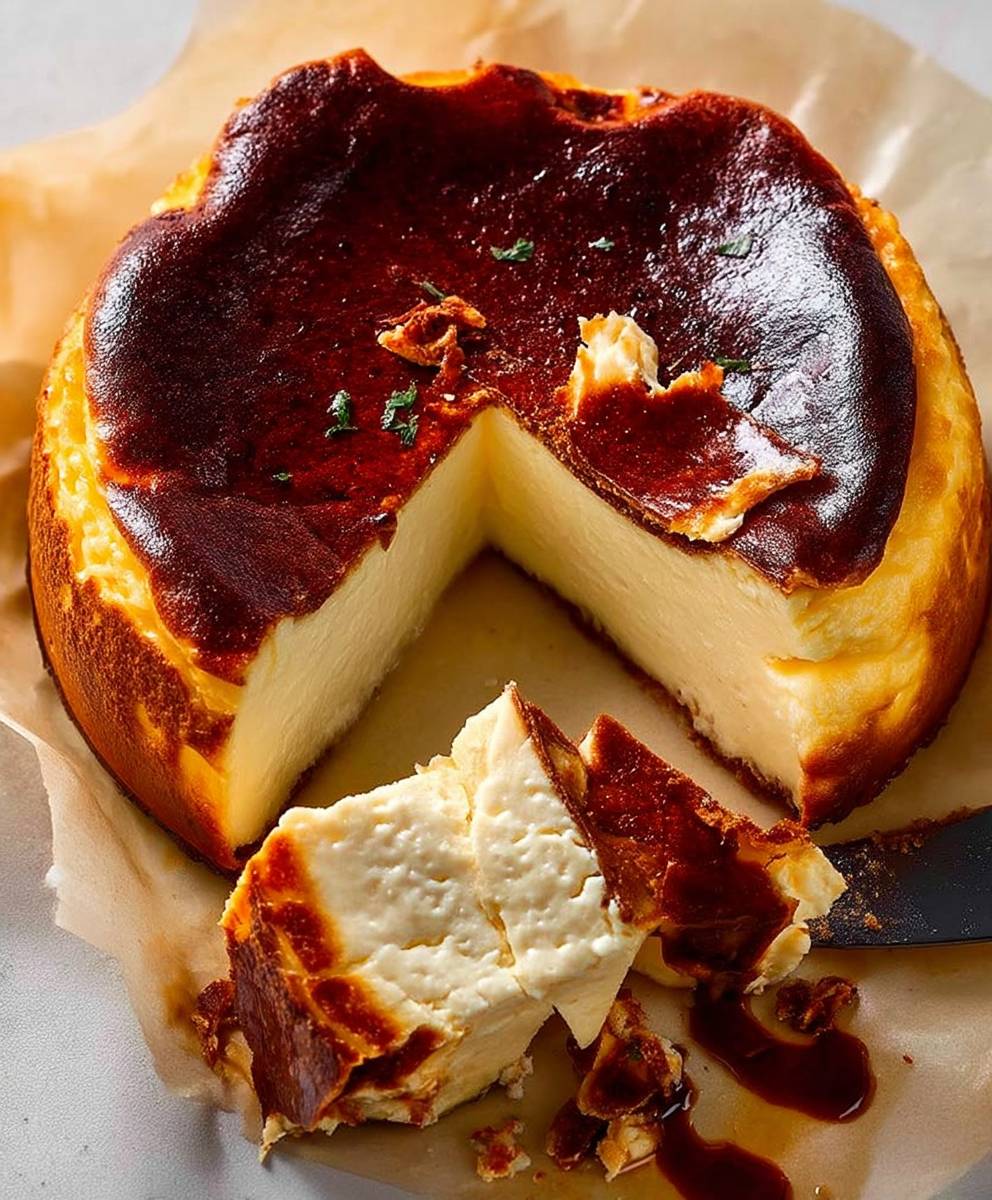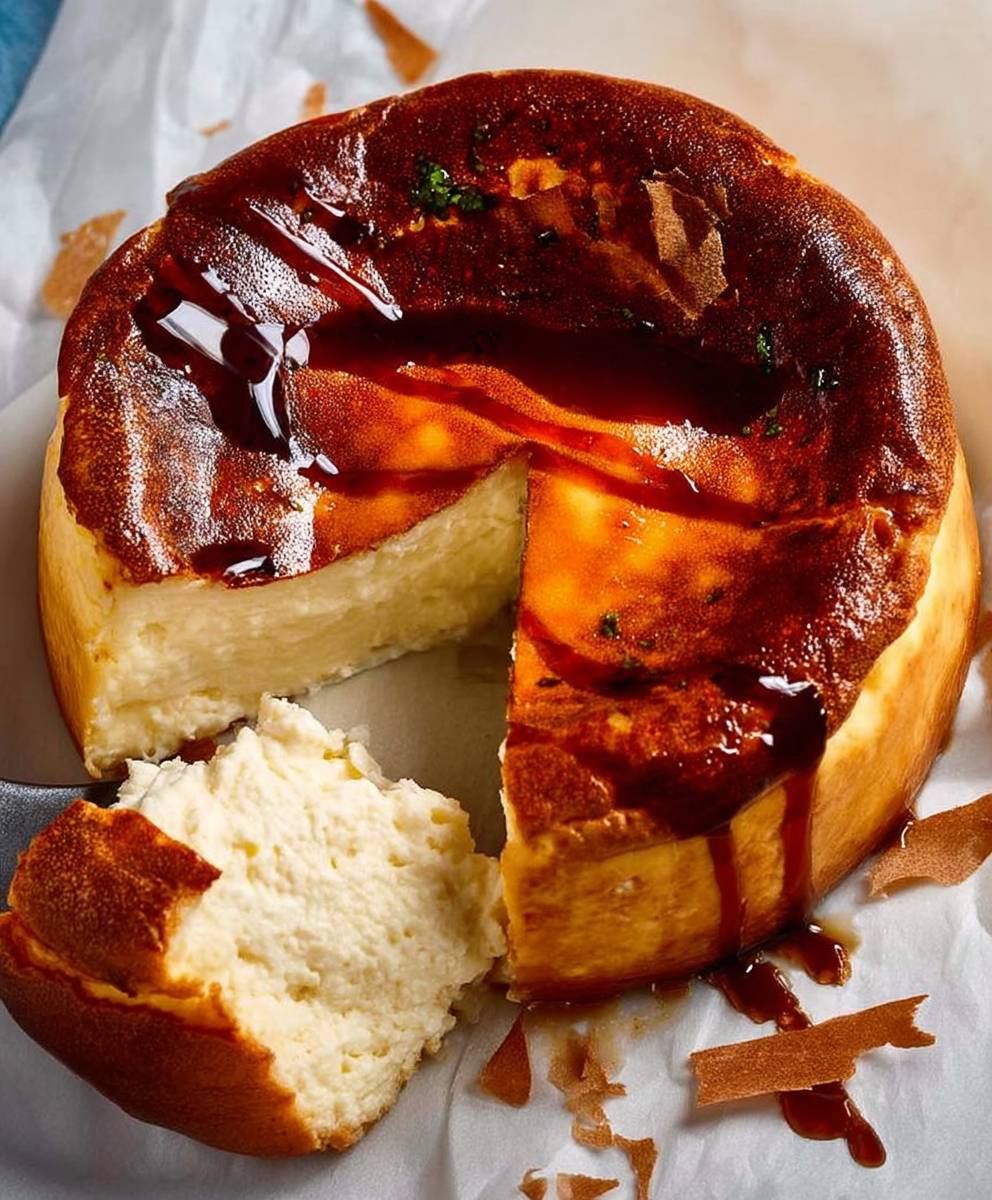Basque Cheesecake: Prepare to be captivated by the rustic charm and intensely delicious flavor of this unique dessert. Forget everything you think you know about cheesecake this isn’t your typical creamy, meticulously decorated slice. This is Basque Cheesecake, a deliberately burnt, crustless wonder that hails from the Basque region of Spain, and it’s about to become your new obsession.
Originating from La Viña restaurant in San Sebastián, Spain, this cheesecake defies convention. It embraces imperfection, celebrating the caramelized, almost burnt exterior that gives way to an unbelievably creamy and custardy interior. The beauty of Basque Cheesecake lies in its simplicity and the contrasting textures it offers. It’s a testament to how a few high-quality ingredients, combined with a bold baking technique, can create something truly extraordinary.
Why do people adore this dessert? It’s the delightful contrast, of course! The slightly bitter, almost toffee-like notes of the deeply browned top perfectly complement the rich, smooth, and almost molten center. It’s also incredibly easy to make, requiring no water bath or complicated steps. This makes it the perfect dessert for both experienced bakers and those just starting their culinary journey. So, are you ready to experience the magic of a truly unforgettable cheesecake? Let’s get baking!
Ingredients:
- 1 kg (2.2 lbs) Cream Cheese, full-fat, softened to room temperature
- 5 large Eggs, room temperature
- 400g (1 3/4 cups) Granulated Sugar
- 500ml (2 cups) Heavy Cream (35% fat or higher)
- 1 teaspoon Vanilla Extract
- 30g (1/4 cup) All-Purpose Flour
- Pinch of Salt
Preparing the Cheesecake Batter:
- Cream the Cream Cheese: In a large mixing bowl, add the softened cream cheese. Using an electric mixer (either a stand mixer with a paddle attachment or a handheld mixer), beat the cream cheese on medium speed until it is completely smooth and creamy. This is a crucial step! You want to eliminate any lumps to ensure a silky smooth cheesecake. This might take 3-5 minutes, depending on the softness of your cream cheese. Scrape down the sides and bottom of the bowl occasionally to ensure even mixing.
- Incorporate the Sugar: Gradually add the granulated sugar to the creamed cheese, about 1/4 cup at a time. Continue beating on medium speed after each addition until the sugar is fully incorporated and the mixture is smooth. Again, scrape down the bowl as needed. Over-mixing at this stage can introduce too much air, which can lead to cracking during baking, so mix until just combined.
- Add the Eggs: Crack the eggs into a separate bowl. Add them one at a time to the cream cheese and sugar mixture, beating on low speed after each addition until just combined. It’s important not to over-mix after adding the eggs, as this can also contribute to cracking. Make sure each egg is fully incorporated before adding the next.
- Incorporate the Heavy Cream and Vanilla: Pour in the heavy cream and vanilla extract. Mix on low speed until just combined. The batter should be smooth and pourable. Don’t worry if it seems a little thin; that’s perfectly normal.
- Add the Flour and Salt: Sift the all-purpose flour into the batter. This helps prevent lumps. Add the pinch of salt. Gently fold the flour and salt into the batter using a spatula until just combined. Be careful not to over-mix. Over-mixing will develop the gluten in the flour, which can result in a tougher cheesecake.
- Final Check: Give the batter one final gentle stir to ensure everything is evenly distributed. The batter should be smooth, creamy, and lump-free.
Preparing the Baking Pan:
- Preheat the Oven: Preheat your oven to 220°C (425°F). It’s important to have a hot oven to achieve the characteristic burnt top of a Basque cheesecake. Make sure your oven is properly calibrated for accurate temperature.
- Prepare the Parchment Paper: This is the key to the rustic look of a Basque cheesecake. You’ll need a 23cm (9-inch) springform pan. Cut two large pieces of parchment paper, significantly larger than the pan. Wet the parchment paper under running water, then squeeze out the excess water. This makes the parchment more pliable and easier to mold into the pan.
- Line the Pan: Press one piece of parchment paper into the pan, allowing the excess to overhang the sides. Repeat with the second piece, overlapping the first. The goal is to completely line the pan, including the sides, with the parchment paper. Don’t worry about making it perfectly smooth; the wrinkles and creases are what give the Basque cheesecake its signature look. Ensure there are no gaps where the batter could leak out.
- Secure the Parchment: Gently press the parchment paper against the sides and bottom of the pan, creating a secure lining. The parchment should extend several inches above the rim of the pan.
Baking the Cheesecake:
- Pour in the Batter: Carefully pour the cheesecake batter into the prepared springform pan. The batter should come almost to the top of the parchment paper lining.
- Bake: Place the springform pan in the preheated oven. Bake for 50-60 minutes, or until the top of the cheesecake is deeply browned and almost burnt-looking. The center should still be slightly jiggly. The exact baking time will depend on your oven, so keep a close eye on it. If the top is browning too quickly, you can loosely tent it with foil for the last 10-15 minutes of baking.
- Cooling: Once the cheesecake is done, turn off the oven and crack the oven door slightly. Let the cheesecake cool in the oven for about 30-60 minutes. This gradual cooling helps prevent cracking.
- Refrigerate: After the initial cooling in the oven, remove the cheesecake from the oven and let it cool completely at room temperature. Then, cover it loosely with plastic wrap and refrigerate for at least 4 hours, or preferably overnight. This allows the cheesecake to set properly and develop its flavor.
Serving and Storing:
- Unmold: Once the cheesecake is thoroughly chilled, carefully remove it from the springform pan. Gently peel away the parchment paper.
- Slice and Serve: Slice the cheesecake into wedges and serve. Basque cheesecake is best served at room temperature or slightly chilled.
- Garnish (Optional): You can garnish the cheesecake with fresh berries, a dusting of powdered sugar, or a drizzle of caramel sauce, but it’s delicious on its own.
- Storing: Store leftover cheesecake in an airtight container in the refrigerator for up to 3-4 days. The flavor may even improve slightly after a day or two.
Tips for Success:
- Use Full-Fat Cream Cheese: This is essential for a rich and creamy cheesecake. Low-fat or fat-free cream cheese will not work as well.
- Room Temperature Ingredients: Using room temperature cream cheese and eggs ensures that the batter mixes smoothly and evenly.
- Don’t Over-Mix: Over-mixing the batter can lead to a tough cheesecake. Mix until just combined after each addition.
- Embrace the Burnt Top: The burnt top is what gives Basque cheesecake its unique flavor and appearance. Don’t be afraid to let it get dark!
- Parchment Paper is Key: The parchment paper lining is essential for creating the rustic look and preventing the cheesecake from sticking to the pan.
- Cooling is Important: Gradual cooling helps prevent cracking.
- Chill Thoroughly: Chilling the cheesecake for at least 4 hours allows it to set properly and develop its flavor.
- Adjust Baking Time: Baking times may vary depending on your oven. Keep a close eye on the cheesecake and adjust the baking time as needed.
- Don’t Worry About Cracks: Unlike traditional cheesecakes, cracks are perfectly acceptable (and even expected) in a Basque cheesecake.
Troubleshooting:
- Cheesecake is too dense: This could be due to over-mixing the batter or using cold ingredients.
- Cheesecake cracked: This could be due to baking at too high a temperature, over-mixing the batter, or cooling the cheesecake too quickly. While cracks are acceptable, minimizing them can be achieved by following the cooling instructions carefully.
- Cheesecake is not setting: This could be due to not using full-fat cream cheese or not chilling the cheesecake long enough.
- Cheesecake is too dry: This could be due to over-baking the cheesecake.
- Cheesecake is sticking to the pan: Make sure you use plenty of parchment paper and that it is properly secured to the pan.
Enjoy your delicious Basque Cheesecake! I hope you find this recipe easy to follow and that it brings you as much joy as it brings me. This is a truly special dessert that is sure to impress your friends and family.

Conclusion:
And there you have it! This Basque Cheesecake isn’t just another dessert; it’s an experience. The intentionally burnt exterior gives way to a creamy, almost custard-like interior that’s simply divine. It’s a symphony of textures and flavors that will tantalize your taste buds and leave you craving more. I truly believe this is a must-try recipe for any baking enthusiast, regardless of your skill level. Its simplicity is deceptive; the end result is a showstopper that will impress your friends and family.
Why is it a must-try? Because it’s incredibly easy to make, requires minimal ingredients, and delivers maximum flavor. Forget fussy decorations and complicated techniques. This Basque Cheesecake celebrates imperfection, embracing the rustic charm of its caramelized surface. It’s a forgiving recipe, perfect for those days when you want a delicious treat without the stress of intricate baking. Plus, the unique flavor profile sets it apart from your average cheesecake. The slight bitterness from the burnt top perfectly complements the sweet and creamy interior, creating a balanced and unforgettable dessert.
But the fun doesn’t stop there! This recipe is also incredibly versatile. While I personally love it served chilled and plain, allowing the flavors to truly shine, there are endless possibilities for customization. For a touch of elegance, try serving it with a dollop of whipped cream and a sprinkle of fresh berries. A drizzle of honey or a dusting of cocoa powder also adds a delightful touch.
Looking for variations? Consider infusing the batter with different flavors. A splash of vanilla extract, a hint of citrus zest (lemon or orange work beautifully), or even a pinch of cinnamon can elevate the flavor profile. For a richer, more decadent experience, try adding a tablespoon or two of your favorite liqueur, such as Amaretto or Frangelico. You could even swirl in some melted chocolate before baking for a marbled effect.
Another fun variation is to experiment with different cheeses. While cream cheese is the traditional choice, you can try substituting a portion of it with mascarpone or ricotta cheese for a slightly different texture and flavor. Just be sure to adjust the sugar accordingly, as some cheeses are naturally sweeter than others.
Serving suggestions are plentiful. This Basque Cheesecake is perfect as an after-dinner dessert, a centerpiece for a brunch gathering, or even a special treat for yourself on a cozy night in. Pair it with a glass of dessert wine, a cup of coffee, or a simple glass of milk. No matter how you choose to enjoy it, I guarantee it will be a memorable experience.
I’m so excited for you to try this recipe! It’s become a staple in my own kitchen, and I know it will become one of your favorites too. Don’t be intimidated by the “burnt” appearance; that’s what makes it so special! Embrace the imperfections and enjoy the process.
Once you’ve made your own Basque Cheesecake, I would absolutely love to hear about your experience. Did you try any variations? What did you think of the flavor and texture? Share your photos and stories in the comments below! I can’t wait to see your creations and hear your feedback. Happy baking! And remember, don’t be afraid to experiment and make it your own. The beauty of baking lies in the creativity and the joy of sharing delicious food with loved ones. So go ahead, give this recipe a try, and let the magic of the Basque Cheesecake unfold in your kitchen. You won’t regret it!
Basque Cheesecake: The Ultimate Guide to Burnt Perfection
A simple, crustless Basque Cheesecake with a deeply caramelized top and a creamy, custardy interior.
Ingredients
- 1 kg (2.2 lbs) Cream Cheese, full-fat, softened to room temperature
- 5 large Eggs, room temperature
- 400g (1 3/4 cups) Granulated Sugar
- 500ml (2 cups) Heavy Cream (35% fat or higher)
- 1 teaspoon Vanilla Extract
- 30g (1/4 cup) All-Purpose Flour
- Pinch of Salt
Instructions
- Cream the Cream Cheese: In a large mixing bowl, beat the softened cream cheese on medium speed until completely smooth and creamy (3-5 minutes). Scrape down the sides and bottom of the bowl occasionally.
- Incorporate the Sugar: Gradually add the granulated sugar to the creamed cheese, about 1/4 cup at a time. Continue beating on medium speed after each addition until fully incorporated and smooth. Scrape down the bowl as needed. Mix until just combined.
- Add the Eggs: Crack the eggs into a separate bowl. Add them one at a time to the cream cheese and sugar mixture, beating on low speed after each addition until just combined. Make sure each egg is fully incorporated before adding the next.
- Incorporate the Heavy Cream and Vanilla: Pour in the heavy cream and vanilla extract. Mix on low speed until just combined.
- Add the Flour and Salt: Sift the all-purpose flour into the batter. Add the pinch of salt. Gently fold the flour and salt into the batter using a spatula until just combined. Be careful not to over-mix.
- Final Check: Give the batter one final gentle stir to ensure everything is evenly distributed. The batter should be smooth, creamy, and lump-free.
- Preheat the Oven: Preheat your oven to 425°F (220°C).
- Prepare the Parchment Paper: Cut two large pieces of parchment paper, significantly larger than a 9-inch (23cm) springform pan. Wet the parchment paper under running water, then squeeze out the excess water.
- Line the Pan: Press one piece of parchment paper into the pan, allowing the excess to overhang the sides. Repeat with the second piece, overlapping the first. Ensure there are no gaps where the batter could leak out.
- Secure the Parchment: Gently press the parchment paper against the sides and bottom of the pan, creating a secure lining. The parchment should extend several inches above the rim of the pan.
- Pour in the Batter: Carefully pour the cheesecake batter into the prepared springform pan.
- Bake: Place the springform pan in the preheated oven. Bake for 50-60 minutes, or until the top of the cheesecake is deeply browned and almost burnt-looking. The center should still be slightly jiggly. If the top is browning too quickly, you can loosely tent it with foil for the last 10-15 minutes of baking.
- Cooling: Once the cheesecake is done, turn off the oven and crack the oven door slightly. Let the cheesecake cool in the oven for about 30-60 minutes.
- Refrigerate: After the initial cooling in the oven, remove the cheesecake from the oven and let it cool completely at room temperature. Then, cover it loosely with plastic wrap and refrigerate for at least 4 hours, or preferably overnight.
- Unmold: Once the cheesecake is thoroughly chilled, carefully remove it from the springform pan. Gently peel away the parchment paper.
- Slice and Serve: Slice the cheesecake into wedges and serve. Basque cheesecake is best served at room temperature or slightly chilled.
- Garnish (Optional): You can garnish the cheesecake with fresh berries, a dusting of powdered sugar, or a drizzle of caramel sauce, but it’s delicious on its own.
- Storing: Store leftover cheesecake in an airtight container in the refrigerator for up to 3-4 days.
Notes
- Use full-fat cream cheese for the best results.
- Room temperature ingredients are crucial for a smooth batter.
- Don’t over-mix the batter after adding the eggs or flour.
- Embrace the burnt top it’s what makes this cheesecake special!
- The parchment paper lining is essential for the rustic look and preventing sticking.
- Gradual cooling helps prevent cracking.
- Chilling thoroughly allows the cheesecake to set properly.
- Baking times may vary depending on your oven.
- Don’t worry about cracks they’re part of the charm!

